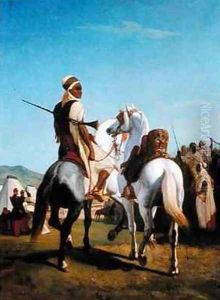ouis Eugene Ginain Paintings
Louis-Eugène Ginain was a French architect born on January 25, 1825, in Sens, France. He was a significant figure in 19th-century French architecture, known for his contributions to the historicist Beaux-Arts style that dominated French architecture during his time. Ginain's education began at the École des Beaux-Arts in Paris, where he was a pupil of Louis-Hippolyte Lebas and Henri Labrouste, two prominent architects of the era.
Ginain's career was marked by several prestigious awards and positions, reflecting his prominence in French architecture. He won the coveted Prix de Rome in 1851, which allowed him to study at the French Academy in Rome, the Villa Medici, for a period of five years. This experience greatly influenced his architectural style, which often incorporated elements of classical architecture with Renaissance and Baroque influences.
Upon his return to France, Ginain worked on various public commissions and was involved in the restoration of historic buildings, a common practice among French architects of the time who were influenced by the theories of Eugène Viollet-le-Duc. Throughout his career, Ginain held various influential positions, including being a professor at the École des Beaux-Arts, where he taught many students who would go on to become notable architects themselves.
One of Ginain's notable works includes the completion of the Tribunal de Commerce (Commercial Court) in Paris, which was left unfinished by his teacher Henri Labrouste. His work was characterized by a strong emphasis on symmetry, proportion, and the use of classical orders, typical of the Beaux-Arts approach to architecture.
Louis-Eugène Ginain passed away on August 18, 1898, in Paris. His legacy is remembered for his role in perpetuating the Beaux-Arts tradition in French architecture and his influence on the generations of architects who followed him. His contributions to the architectural landscape of 19th-century France continue to be studied and admired by architects and art historians alike.
